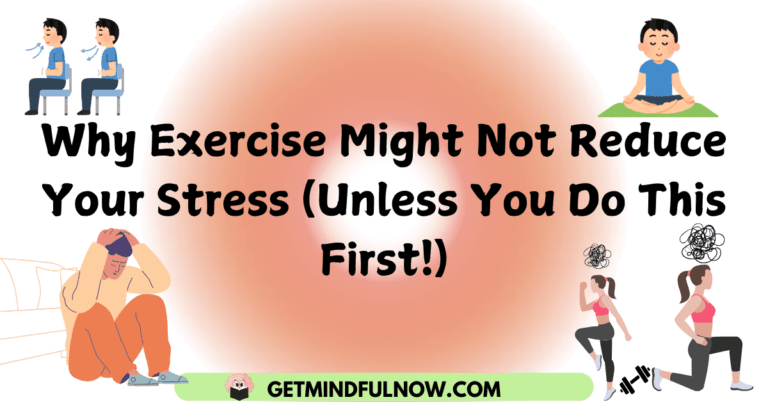Wait… Does Exercise Really Reduce Stress?
We’ve all heard it: “Just work out, and you’ll feel better!” But what if that’s not the full story? What if your emotional state determines whether exercise actually helps or just feels like another chore?
A fascinating (and somewhat paradoxical) truth is emerging: Exercise doesn’t always reduce stress, unless your mind is in the right place.
The Surprising Study That Challenges What We Know
A study conducted at Yale University about 20 years ago tested this idea. Two groups of actors were asked to evoke strong emotions, one group focused on negative emotions, the other on positive ones. Then, they all did light exercises.
The results?
- The negative emotion group showed no noticeable benefits from the exercise.
- The positive emotion group experienced increased well-being and mood improvement.
This suggests that our mental state can influence whether exercise actually helps us feel better.
The Stress-Exercise Paradox
Here’s where it gets tricky, most people turn to exercise because they’re stressed. But if they’re already in a negative emotional state, their body might not even register the benefits of movement.
When we feel stressed or overwhelmed, our autonomic nervous system (ANS) switches on, activating the sympathetic nervous system (SNS). This triggers a chain reaction:
- The brain detects stress and sends a signal down the spinal cord.
- The signal travels through the spinal nerves to the peripheral nervous system.
- The message reaches the adrenal glands, prompting the release of epinephrine (adrenaline).
- Epinephrine floods the body, increasing heart rate, muscle tension, and alertness.

At this point, the body is primed for survival, not relaxation. If someone jumps into exercise in this state, their nervous system might interpret it as an extension of stress rather than a relief from it.
A Real-Life Example of This Stress Response in Action
Imagine Sarah, a young professional, walking into a business meeting, only to see her ex sitting across the table. The sight instantly triggers a wave of past emotions, pain, regret, unresolved tension. Her brain, perceiving this as a threat, sends distress signals down her spinal cord, activating her sympathetic nervous system. Her heart starts racing, her palms get sweaty, and her breathing becomes shallow.
Even after the meeting, the stress lingers. If Sarah goes straight to the gym in this heightened state, she might push through a workout, but the underlying emotional storm remains unchecked. The adrenaline-fueled thoughts about her past relationship could continue looping in her mind, making her feel just as tense post-exercise as she did before.
This is why self-regulation is key. If Sarah first took a moment to breathe deeply, acknowledge her emotions, or even do a short mindfulness exercise, she could break the cycle. Only then would her workout truly serve as a stress reliever rather than just another form of distraction.
Why Self-Regulation is the Missing Piece
Most of us have been told that exercise is the ultimate stress buster. And while that’s true, how we enter a workout matters just as much as the workout itself. If your body is already in a high-stress state, heart racing, thoughts spiraling, emotions overwhelming, you might not experience the full benefits of movement.
Think of stress like a storm in the brain. If we jump straight into exercise, it’s like trying to run in heavy rain, we might just feel heavier. But if we calm the storm first, movement becomes a way to enhance relaxation rather than force it.
How to Regulate Before Exercise for Maximum Stress Relief
To truly allow exercise to work its magic on your mind and body, you first need to regulate your nervous system. Here’s how:
1. Breathwork – Signal Safety to Your Nervous System
When you’re stressed, your breathing becomes shallow and rapid. This sends a signal to your brain that you’re in danger, keeping you locked in a fight-or-flight response. Before exercising, using intentional breathwork can activate your parasympathetic nervous system, which promotes relaxation and balance.
Try This: The 4-7-8 Breathing Technique
- Inhale deeply through your nose for 4 seconds.
- Hold your breath for 7 seconds.
- Exhale slowly through your mouth for 8 seconds.
- Repeat for at least three rounds.
This slows your heart rate, reduces cortisol (the stress hormone), and sends a powerful message to your body: “I am safe.”
If deep breathing feels unnatural, simply focus on extending your exhales, as this alone can calm your nervous system.
2. Mindful Awareness – Acknowledge, Don’t Suppress
A lot of people push themselves into exercise as a way to escape stress. But ignoring emotions doesn’t make them disappear—it just buries them deeper.
Instead of forcing yourself into movement with unresolved tension, take a moment to acknowledge what’s going on inside.
Try This: The “Name It to Tame It” Method
- Close your eyes and notice the emotions present.
- Say to yourself, “I am feeling _______.” (anxious, frustrated, overwhelmed, etc.)
- Remind yourself: “It’s okay to feel this way. I don’t have to fix it right now.”
By simply naming the emotion, you reduce its intensity. Studies show that when we acknowledge emotions rather than resist them, our amygdala (the fear center of the brain) calms down, allowing us to shift into a more balanced state.
Before jumping into your workout, take just one minute to check in with yourself. This will ensure that exercise becomes a tool for healing, not a way to ignore what needs attention.
3. Positive Visualization – Shift Your Mindset Before You Move
If you’ve ever dragged yourself to a workout with resistance, thinking, “Ugh, I just have to get through this,” your brain likely treated it as a chore rather than a stress reliever.
Visualization helps change that. By imagining a positive outcome, you prime your brain to associate exercise with relief, rather than effort.
Try This: The Pre-Workout Visualization
- Close your eyes for 30 seconds.
- Picture yourself moving through your workout effortlessly.
- Imagine the release you’ll feel when you’re done—lighter, clearer, energized.
- Tell yourself: “This workout is a gift to myself, not a punishment.”
When you do this, your dopamine levels rise, making you more motivated and increasing the chances of feeling great afterward.
4. Gentle Movement First – Ease Your Body Into Exercise
If your body is tense and your mind is racing, jumping straight into high-intensity exercise can backfire. Your nervous system might interpret it as added stress rather than relief.
Instead, start slow. This helps your body transition from fight-or-flight mode to a more adaptive, relaxed state, allowing the full benefits of exercise to take effect.
Try This: The 5-Minute Pre-Workout Reset
- Stretch: Reach your arms up, roll your shoulders, and gently stretch your spine.
- Slow Walk: Walk around for a minute or two, focusing on each step.
- Shake It Out: Shake your arms and legs lightly to release tension.
- Deep Breaths: Inhale deeply as you move, exhale tension with each breath.
This small transition prepares your body and mind to get the most out of your workout.
Final Thought: Movement as an Extension of Mindset
Exercise should be a stress reliever, but to make it truly effective, we need to prepare our nervous system first. If we shift the goal from “using exercise to escape stress” to “exercising from a place of balance,” we might actually experience the stress-relieving benefits we’ve been promised all along.
So next time you’re feeling stressed, don’t just throw yourself into a workout. Pause. Regulate. Then move.
Because the truth is, a regulated mind allows exercise to reduce stress.
By doing this, you’re not just exercising, you’re creating a mind-body practice that truly works in your favor. 💙
Reference of Study: Evolve Your Brain- The Science of Changing your Mind, Chapter No Eight








